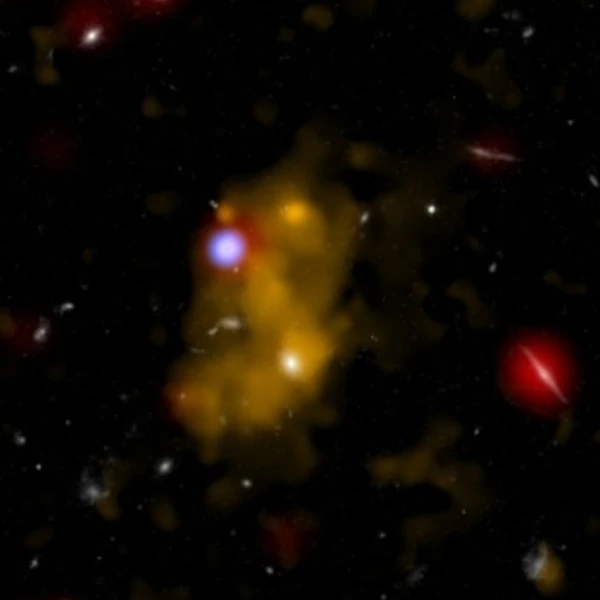
Lyman-alpha blobs are extensive regions of neutral hydrogen gas ionized by the intense ultraviolet radiation emitted by the first galaxies formed in the young Universe. This phenomenon occurs during the era of cosmic reionization, a key phase between approximately 400 million and 1 billion years after the Big Bang, where intergalactic gas transitions from a neutral to an ionized state. Observing and modeling these blobs allow us to study the nature of the first light sources, the structuring of the primordial Universe, as well as the physical mechanisms related to the diffusion and absorption of Lyman-alpha radiation.
Lyman-alpha radiation corresponds to the electronic transition of a hydrogen atom when the electron falls back from level 2 to the ground level 1, with a wavelength in a vacuum of \(\lambda_{Ly\alpha} = 121.567\) nm, in the near ultraviolet. The Lyman-alpha line is extremely resonant, meaning that the emitted photons are very strongly scattered by the surrounding neutral hydrogen. This multiple scattering leads to complex spectral profiles and an extended spatialization of the observed signal, often in the form of blobs.
The formation of a Lyman-alpha blob begins with the emission of ionizing UV photons from young massive stars or nascent supermassive black holes in the first galaxies. These photons ionize the surrounding neutral gas, forming a region of ionized hydrogen (HII). The recombination of protons and electrons in this region emits Lyman-alpha photons, which then escape into the surrounding Universe. The typical size of these blobs is on the order of several hundred kiloparsecs to a few megaparsecs, depending on the luminosity of the sources and the density of the medium.
The temporal and spatial evolution of these blobs is governed by the radiative transfer equation coupled with hydrodynamic dynamics and hydrogen chemistry. Numerical models solve the Boltzmann equation for the distribution of Lyman-alpha photons: \( \frac{1}{c}\frac{\partial I_{\nu}}{\partial t} + \mathbf{n} \cdot \nabla I_{\nu} = -\kappa_{\nu} I_{\nu} + j_{\nu} \)
Lyman-alpha blobs are primarily detected by their diffuse Lyman-alpha emission at high redshifts (\(z \sim 6-10\)), using instruments sensitive to wavelengths shifted to the near-infrared. These observations provide constraints on:
Lyman-alpha blobs, by their size and distribution, trace the topology of reionization, a crucial parameter for validating cosmological models of structural formation.
Lyman-alpha blobs represent essential witnesses of the cosmic era when the first luminous structures transformed the Universe. They are fossil imprints of the galactic dawn. They help us understand the end of the "Dark Ages" from ≈ 380,000 years (end of recombination after the Big Bang) to 500 million to 1 billion years after the Big Bang (beginning of reionization, triggered by the first stars and galaxies).